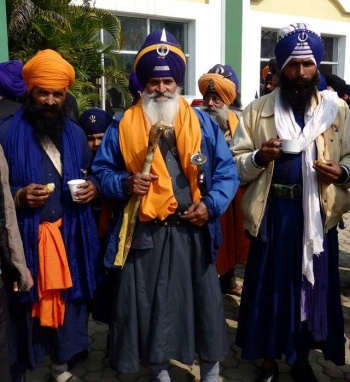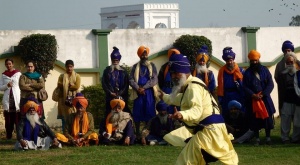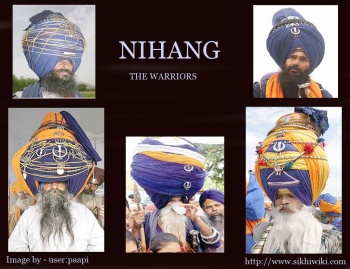Nihang
Nihangs (also: called Akalis) are a very famous and prestigious armed Sikh order. Early Sikh military history is dominated by the Akali Sikh military order that is particularly noted for the many famous military victories they won, often while they were heavily out-numbered. The Nihungs have historically been held in great affection and respect by Sikhs due the pivotal role they have played in Sikh history and Sikh military history in particular. The Nihang's activities are currently mostly ceremonial, as it is peace time but in times of war for the Sikh religion the Akalis have historically spear-headed the attack on the enemy. As per history and traditions, Nihang armymen are considered as son of Guru Gobind Singh and Mata Sahib Devan.
Etymology
Acc to Guru Shabad Ratnakar Mahan Kosh, encyclopedia by Kahn Singh Nabha, Following are different meanings of Nihang:
- The Sword - ਖੜਗ. ਤਲਵਾਰ. "ਬਾਹਤ ਨਿਹੰਗ। ਉੱਠਤ ਫੁਲਿੰਗ." (ਸਲੋਹ) ਤਲਵਾਰ ਦੇ ਪ੍ਰਹਾਰ ਤੋਂ ਵਿਸ੍ਫੁਲਿੰਗ (ਚਿੰਗਾੜੇ) ਨਿਕਲਦੇ ਹਨ।
- The Pen (Writer) - ਕਲਮ. ਲੇਖਨੀ -
- The Alligator - ਘੜਿਆਲ. ਮਗਰਮੱਛ. (मकर मत्स्य) ਨਾਕੂ. Alligator. "ਜਨੁਕ ਲਹਿਰ ਦਰਯਾਵ ਤੇ ਨਿਕਸ੍ਯੋ ਬਡੋ ਨਿਹੰਗ." (ਚਰਿਤ੍ਰ ੨੧੭)
- The Horse - ਡਿੰਗ- ਘੋੜਾ. ਅਸ਼੍ਵ. ਤੁਰੰਗ. "ਬਿਚਰੇ ਨਿਹੰਗ। ਜੈਸੇ ਪਿਲੰਗ." (ਵਿਚਿਤ੍ਰ) ਚਿਤ੍ਰੇ ਵਾਂਙ ਛਾਲਾਂ ਮਾਰਦੇ ਘੋੜੇ ਵਿਚਰੇ। - The Horse
- Unrestrained - ਸੰ. निः शङ्क ਨਿਹਸ਼ੰਕ. ਵਿ- ਜਿਸ ਨੂੰ ਮੋਤ ਦੀ ਚਿੰਤਾ ਨਹੀਂ. ਬਹਾਦੁਰ. ਦਿਲੇਰ. "ਨਿਰਭਉ ਹੋਇਓ ਭਇਆ ਨਿਹੰਗਾ." (ਆਸਾ ਮਃ ੫) "ਪਹਿਲਾ ਦਲਾਂ ਮਿਲੰਦਿਆਂ ਭੇੜ ਪਿਆ ਨਿਹੰਗਾ." (ਚੰਡੀ ੩)
- Detached: ਸੰ. निः सङ्ग- ਨਿਹਸੰਗ. ਨਿਰਲੇਪ. ਆਤਮਗ੍ਯਾਨੀ. ਦੁੰਦ (ਦ੍ਵੰਦ੍ਵ) ਦਾ ਤਿਆਗੀ. "ਨਿਹੰਗ ਕਹਾਵੈ ਸੋ ਪੁਰਖ ਦੁਖ ਸੁਖ ਮੰਨੇ ਨ ਅੰਗ." (ਪ੍ਰਾਪੰਪ੍ਰ) "ਮੁੱਲਾ ਬ੍ਰਾਹਮਣ ਨਾ ਬੁਝੈ ਬੁਝੈ ਫਕਰ ਨਿਹੰਗ." (ਮਗੋ)
"Nihang", a Persian word meaning Crocodile, was the name given to the Akali's by the invading Mughals who said they fought ferociously like crocodiles.
The Nihangs were also known as Akalis. The term "Akali" is said to be derived from the Sanskrit Akal Purusha (Akal Purukh in Punjabi) - "the Timeless One", a term for God. Thus 'Akali' translates as "A Servent of the Timeless God".
What is Nihang?
Anyone who lives free from fear is called a ‘Nihang’. In Raag Aasa Guru Arjan dev Ji has described ‘Nihang’ in this manner:
| (Ang 392, SGGS) |
| "nirbhau hoeiou bheiaa nihangaa
Being fearless, he becomes a ‘Nihang’ (bold and daring person)." |
Describing the Nihang the old Panth Prakaash states:
| "nihang kahaavai so purakh, dukh sukh manne na ang.(praapanpraa)
A person who has forsaken the fear of death and is always ready to embrace martyrdom is called a Nihang." |
Nihang Singhs are unattached to worldly materials. They wear blue clothes and tie a turban that is a foot high with a “dumala” on top of it. They always keep several weapons such as chakars or a khanda on themselves.
The Nihangs, the 'Dare Devils' of the Sikh Panth, are members of an order established by Guru Gobind Singh Ji more than 300 years ago. Renowned for their martial skills the Nihangs (men such as Akali Phula Singh) are the Vanguards of the Sikh nation, whose vocation in life is to be a warrior and protect the Gurdwaras and be on the forefront of battles. Though there is no concrete account of how the Nihangs came about, it is told by many Singhs that one day the three Sahibzaadey (princes of Guru Gobind Singh Ji) were performing their battle skills, and the youngest of them all Baba Fateh Singh Ji also wanted to play with his brothers. The other brothers replied: “At the moment you are too small.”
The Sahibzaadey felt so let down, that he went inside the palace and tied a dastaar (turban) as tall as one hand. He put on a blue dress. Placed a Chakar (round disc carried on a belt or worn on the turban) on himself. He adorned himself with a small Khanda. Over his dastaar he wrapped a ‘dumalla’ and in he held in his hand a spear, with wore his Kirpaan. He then went to where his brothers were playing and said, “Now I don’t look small.”
Seeing his son, looking so handsome and beautiful, Guru Ji said: “From this dress the Nihangs will be formed.”
For this reason up to this day Nihang Singhs are called ‘Guru Gobind Singh Ji’s Laddleeaa Faujaa(n) (Beloved Army)’.
Another story relates that Guru Gobind Singh Ji was (so) impressed by Bhai Maha Singh’s dress, character and fighting skills that Guru Ji said, “You will have your own Panth”. However, this story makes no sense. Would Guru Gobind Singh Ji want his Sikhs to follow the Guru’s Panth and path or follow the Panth and path of individual Sikhs? Therefore, these myths can be dismissed.
Guru Gobind Singh Ji said that the Nihangs will be generous, follow strict adherence to Dharma. When the sword is wielded, it will give out sparks like fireworks are going. Fighting in the battlefield in this way it will seem like a crocodile is coming out of the sea:
| (charitr 297) |
| "januk lahir daryaav te
niksiyo baddo nihang. dharam ke su dhol dhaam, dharitaa ke dharaadhar, dhaaraa dhar moud shau vinod barsat hai." |
The Nihang Singhs were the image of spotless character:
(charitr 297)boohaa khol(h) de nisang,
aae nee nihang.'
“Open the door, do not be afraid,
a Nihang has come your house.”}}
They used to lead such an intrepid and unpredictable lifestyle that even their family did not know of their whereabouts. While riding or fighting they always uttered “Akaal, Akaal”. That is why they also become known as “Akaalis”. Their language (the distinct language of the Khalsa) indicated their positive (Chardikala) attitude. For example:
- To die (Marnaa) – Charhaaee karnaa
- Sickness (Beemaaree) – Dharam Raaj di dhee seva kar rehee hai
(literal meaning is ‘daughter of the angel of death’)
- Punishment to a guilty (Kukarmee nu sazaa milann) – Shaheedi maar
- Chickpeas (Sholay) – Badaam
- Salt (Loon) – Sarab rass
- A little (Thoree) – Sawaayaa
(literal meaning is ‘one and a quarter’)
- When there is nothing/ run out (Kujh Naa hon) – Mast
- Grass (Ghaah) – Haraa pallaa
- Shanty (Tuttee hoyee chhann) – Sheesh Mahal
(literal meaning is a ‘mirrored palace’)
- Calamity (Museebat) – Swarag
(literal meaning ‘heaven’)
- Worn out scarf (Godrree) – Hazaar mekhee
- Coarse grain (Mottaa Ann) – Gurmukhi Parshaad
- Rupees – Chhillar
(literal meaning is ‘bark of a tree’)
- Someone loose on Sikh conduct (Rehat vich Dhiley) – Dabrroo Ghusrooh
- One (Ek) – Savaa lakh
(literal meaning is ‘one hundred twenty five thousand’)
- Sleep (Neend) – Dharam Raaj di dhee
- Oneself – Fauj
Bhai Kahn Singh Ji beautifully describes the true character of an Akaali, of someone who associates themselves to Akaal (the Immortal), this passage in particular is used for Nihang Singhs in the Gur Shabd Ratnaakar Mahaan Kosh (1931):
| "vaaheguroo jee kaa khaalsaa.
kamal jayo maayaa jal vich hai alep sadaa sabh daa sanejee chaal sabh to niraalee hai, karke kamaaee khaave mangnnaa haraam jaanne bhaanne vich vipdaa noo manne kush-haalee hai, svaarath to binaa gurduvaariaa(n) daa chaukeedaar dharam de jang le-ee charre mukh laalee hai, phooje naa akaal binaa hor ke-ee devee dev sikh dashmesh daa so keheeai 'akaalee' hai. The Khalsa belongs to Vaheguru. He who loves all and whose ways are distinct from all, He who eats only that which he earns and considers begging a sin, He who in difficult times has faith in True Guru and remains happy, He who guards the Sikh temples without a desire for material gain, He who is always eager to fight a just and righteous war, He who worships only the Timeless one and not gods or goddesses, Know such a Sikh of the tenth Guru as an Akaali." |
In summary it can be said that Nihangs are the official army of the Sikh Panth, who are trained in Shastar Vidiaa and live a life dedicated to serving the Sikh Panth through their battle skills. They are the Boy Scouts of the Sikhs, where there is progression from young Nihangs (Tarna Dal) to older Nihangs (Buddha Dal). They were blessed by Guru Gobind Singh Ji to remain distinct and be fearless warriors, like an official unpaid army without the desire of material gain.
The Nihang attire
The Nihangs differ essentially from all other Sikh orders in being a militaristic organisation. The Nihangs wear chequered dresses of a particular shade of blue known as "electric-blue".bangles or bracelets of steel round their wrists (Kara), and quoits of steel (Chakra) in their lofty conical blue turbans, together with daggers, knives and swords of varying sizes (Kirpan), and an iron chain.
Nihangs/Akalis today
The Akali headquarters was the Akal Bunga at Amritsar, where they assumed the lead in directing religious ceremonies and convoking the Gurmat; indeed, they laid claim to exercise a general leadership of the whole Sikh community. Since Ranjit Singh's time Anandpur has been their real headquarters, but their influence is still being felt in the world today.
Today, Nihangs foregather in their hundreds at Anandpur, on the occasion of the festival of Hola Mohalla and display their martial skills. This tradition has been in place since the time of Guru Gobind Singh.
Also View
References
- By Gurmukh Singh (Panthic Weekly) - www.panthic.org
- Principal Satbir Singh – ‘Sau Suwal’ (Panjabi)
- Dr. Hakam Singh’s translation & commentary of Principal Satbir Singh work – ‘Sau Suwal – One Hundred Questions’ (English)
- Bhai Kahn Singh – ‘the Gur Shabd Ratnaakar Mahaan Kosh’ (Panjabi)
- Photography of the daily lives of the Nihang Singhs of Punjab by photographer Nick Fleming
| Sects & Cults |
|
♣♣ Ad Dharm ♣♣ Akalis ♣♣ Bandai Sikhs ♣♣ Balmiki ♣♣ Bhatra ♣♣ Brindaban Matt ♣♣ Daya Singh Samparda ♣♣ Dhir Malias ♣♣ Handalis ♣♣ Kabir Panthi ♣♣ Kirtan jatha Group ♣♣ Kooka ♣♣ Kutta Marg ♣♣ Majhabi ♣♣ Manjis ♣♣ Masand ♣♣ Merhbanieh ♣♣ Mihan Sahibs ♣♣ Minas ♣♣ Nirankari ♣♣ Nanak panthi ♣♣ Nanakpanthi Sindhis ♣♣ Namdev Panthi ♣♣ Namdhari ♣♣ Nanaksaria ♣♣ Nihang ♣♣ Nikalsaini ♣♣ Niranjaniye ♣♣ Nirmala ♣♣ Panch Khalsa Diwan ♣♣ Parsadi Sikhs ♣♣ Phul Sahib dhuan ♣♣ Radha Swami ♣♣ Ram Raiyas ♣♣ Ravidasi ♣♣ Ridváni Sikhs ♣♣ Suthra Shahi ♣♣ Sewapanthi ♣♣ Sat kartaria ♣♣ Sant Nirankaris ♣♣ Sanwal Shahis ♣♣ Sanatan Singh Sabhais ♣♣ Sachkhand Nanak Dhaam ♣♣ Samparda Bhindra ♣♣ Tat Khalsa ♣♣ Sikligars ♣♣ Pachhada Jats ♣♣ Satnami's ♣♣ Udasi Sikhs ♣♣ |



